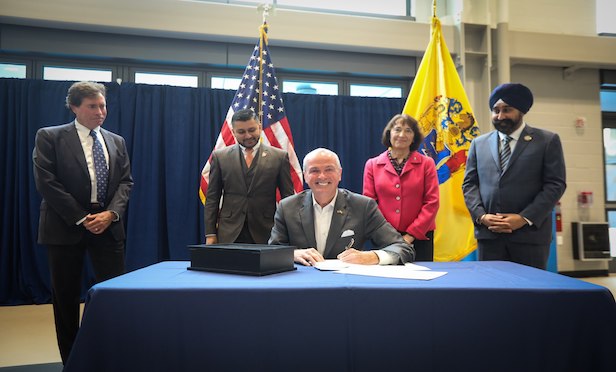 New Jersey Gov. Phil Murphy signed Executive Order No. 89 on Tuesday to establish a Statewide Climate Change Resilience Strategy.
New Jersey Gov. Phil Murphy signed Executive Order No. 89 on Tuesday to establish a Statewide Climate Change Resilience Strategy.
HOBOKEN, NJ— New Jersey Gov. Phil Murphy marked the seventh anniversary of Superstorm Sandy on Tuesday by signing an executive order establishing a Statewide Climate Change Resilience Strategy.
The executive order establishes a Climate and Flood Resilience Program within the New Jersey Department of Environmental Protection, which will be led by a Chief Resilience Officer. Additionally, the order creates an Interagency Council on Climate Resilience, comprised of 16 state agencies to develop short- and long-term action plans that will promote the long-term mitigation, adaptation, and resilience of New Jersey's economy, communities, infrastructure, and natural resources.
"Since taking office, it has been a top priority of my administration to reestablish New Jersey's role as a leader in the fight against climate change and resume many of the climate change initiatives that were dismantled by the Christie administration," said Gov. Murphy. "New Jersey is extremely vulnerable to the impacts of sea-level rise and global warming, and today's Executive Order outlines a bold and comprehensive set of actions to ensure that our communities and infrastructure are more resilient against future storms."
Lt. Gov. Sheila Oliver stated that "factoring climate change into housing rehabilitation efforts in New Jersey is critical because natural disasters are inevitable and unavoidable."
Among the directives to improve New Jersey's climate resilience efforts, the governor's executive order establishes a State of New Jersey Chief Resilience Officer that will lead the Climate and Flood Resilience Program and work with the Interagency Council on Climate Resilience to develop a Statewide Climate Change Resilience Strategy.
The order also establishes a Climate and Flood Resilience Program within the New Jersey Department of Environmental Protection that will develop a scientific report on climate change regarding the current and anticipated effects of climate change in New Jersey, including but not limited to increased temperatures, sea level rise, increased frequency or severity of rainfall, storms, and flooding, at least through 2050. This report will be delivered to the governor within 180 days and updated at least every two years.
Other climate change initiatives included in the order include the establishment of the Interagency Council on Climate Resilience that will be comprised of representatives of 16 state agencies to develop short- and long-term action plans to develop a Statewide Climate Change Resilience Strategy that will include recommendations for actions the state should take to mitigate and adapt to the effects of climate change, including but not limited to the following measures:
• Identify methods that can be used to strengthen resilience;
• Provide guidance and strategies for State agencies, municipalities, and regional planning agencies to implement resiliency measures;
• Promote long-term water and energy resource security;
• Reduce the risk of wildfires in State forests;
• Reduce the risks to the health of New Jersey residents that accompany climate change, such as increased vulnerability to extreme temperatures;
• Support sustainable and resilient economic development;
• Identify funding mechanisms, strategies, and opportunities for coordination; and
• Any other measures necessary to prepare for, mitigate, and adapt to the impacts of climate change.
The strategy will also include a Coastal Resilience Plan that recommends a specific long-term strategy for climate change resilience and adaptation in the coastal areas of the state.
© Touchpoint Markets, All Rights Reserved. Request academic re-use from www.copyright.com. All other uses, submit a request to [email protected]. For more inforrmation visit Asset & Logo Licensing.







